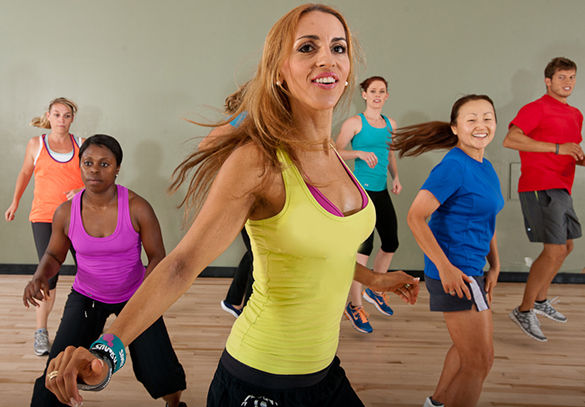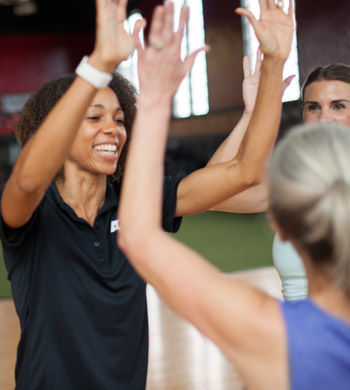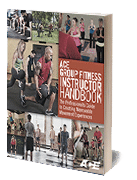
Exceptional group fitness instructors (GFIs) not only teach classes, they take the planning and instructional process one step further to create unparalleled experiences. Outstanding instructors ultimately serve as leaders and coaches who empower participants to develop a positive association with exercise by experiencing physical activity in enjoyable and meaningful ways. While it is imperative to be knowledgeable about human movement, as well as proficient in effectively cueing those movements, a GFI must also be well versed in the art of constructing memorable movement-based experiences to reach and retain more participants.
From building rapport with individuals to implementing strategies to develop group camaraderie, several of the industry’s most experienced and respected group fitness educators offer insight into how you can elevate your class and small-group offerings.
Cultivate Meaningful Connections
While group fitness classes are intended to be both positive and fun, feelings of apprehension or insecurity are not uncommon for those who are new to the experience.
“The group fitness class experience serves as a wonderful platform on which we can create the connection that all humans crave,” says Kimberly Spreen-Glick, senior program director of group fitness and EMPOWER! for Life Time, the Healthy Way of Life Company. “However, group fitness classes can also be intimidating, as participants think, 'Am I doing this right?' and 'Am I being judged?'”
To ease the anxiety and uncertainty that may come along with trying something new, take time and care to develop rapport with individual participants as well as to establish a group dynamic that ensures everyone knows they are valued and can trust that their safety, enjoyment and success is at the top of your mind.
“It’s really up to the instructor to create a safe place for people where they can show up, be accepted, be celebrated and, most importantly, be themselves,” shares Spreen-Glick. “People are energetic beings and it’s the instructor’s responsibility to set the stage for nothing but positive energy during the class experience.”
For veteran GFI and ACE master trainer Andi Wardinsky, it’s imperative that time be spent getting to know participants and making them feel welcomed and appreciated before any movement begins.
“Allowing time before and after class to mingle and get to know participants, and also to empower individuals to converse with one another, is critical to creating an experience that ties participants not only to the class itself, but also to the group as a whole, cultivating a sense of community,” says Wardinsky. Taking advantage of these opportunities to connect with participants enables you to learn participants’ names; gain insight about their goals, experiences and preferences; and also to simply connect with them and ask how they are doing each day and how you can best serve them during the class experience. Wardinsky makes it a point to address participants by name throughout the class itself so that individuals know they are important and are recognized, even in a room of 50 or more people.

“Depending on the class format and size, I try to say each participant’s name once during the class while providing specific positive feedback,” notes Wardinsky. “This works well in classes of 30 participants or less where the format is less choreography-focused, such as a circuit-style or boot-camp class.” For classes that are more choreography heavy, such as dance-based classes or cardio kickboxing, Wardinsky suggests that instructors focus on making eye contact with as many participants as possible to acknowledge each individual’s presence.
In addition to leveraging the time immediately before and after class to build rapport with participants, Beth Jordan, ACE Certified Personal Trainer and owner of Beth’s Bootcamp in Jacksonville Beach, Fla., goes the extra mile in building meaningful relationships with her boot campers.
“During each month, I make a one-on-one appointment with a boot camper—usually a meeting over coffee—to take the time to get to know him or her better and to find out what intrinsically and extrinsically is important to him or her. Then I incorporate specific things into class to help them reach their goals, while inspiring them and also connecting them to the bigger group.”
Jordan also utilizes technology as a way to keep connected with her participants outside of class and to further foster a sense of community and belonging. “I’ve created a Facebook page where I post pictures daily of our group workouts (with expressed written consent from participants), and I also share valuable articles pertaining to health and wellness to further educate and motivate my boot campers,” shares Jordan.
"Nobody cares how much you know until they know how much you care.”
—Theodore Roosevelt
Set The Stage for the Experience
In addition to being an ideal time to build rapport, the beginning and end of a class are also crucial for ensuring participant success and for creating a noteworthy experience. Most instructors agree that the first five minutes and the last five minutes of a class experience are the most memorable among class participants. Internationally recognized group fitness educator and mindful movement coach Lawrence Biscontini, M.A., recommends utilizing a formal, memorized and polished opening and closing statement as a way to define the purpose of a class, set a professional tone and bring the class to an inspirational conclusion.

“Classes address the body, but ‘experiences’ touch the heart,” shares Biscontini. “Putting time into scripting and memorizing the intro and conclusion of your experience (the first and last five minutes) is so important, and it also provides you with an opportunity to share with participants how what they do with you in class on any given day transcends the group fitness environment and helps empower them to become champions of living.”
Opening statements can include, for example, a salutation and personal introduction, an expression of gratitude to participants for attending, acknowledgment of new and familiar faces, a statement regarding class purpose and learning objectives, reference to equipment and specific exercises that will be explored, as well as the introduction of the day’s theme to inspire individuals to stay for the entire experience.
A central theme—which emphasizes a specific aspect of the experience that the instructor would like to make a focal point for participants—is not limited to specific class formats, like yoga, shares Spreen-Glick.
“I often hear instructors say you can only add themes, inspirational quotes and stories in a yoga class, but the same cueing, quotes, stories and positive language can be used when teaching other classes like kickboxing, cycle, HIIT and strength, as people need to be inspired everywhere.”
Themes can take on a wide variety of forms, from emphasizing a specific event or time of year (e.g., a summer solstice-themed yoga class) to highlighting a particular time period or musical genre (i.e., an ‘80s-themed cycling class). The key is that the theme be used to create a more compelling experience by weaving a common thread or element consistently through the class from start to finish, whether it is conveyed through music choices, language options, movement selections or a combination of all three.
Closing statements, like opening statements, may include, for example, a reiteration of the class purpose, a reference to the theme of the experience (if applicable), an offering of insight as to how what was covered in class applies in a meaningful way outside of the group fitness environment, a heartfelt thank you to participants for attending, as well as a compelling reason why they should return to a future class.
Creating Compelling Experiences Using the Five Senses
Biscontini, author of the book Cream Rises: Excellence in Private & Group Fitness Education, suggests exploring creative ways to infuse the five senses of taste, smell, touch, sound and sight to reach participants in a more meaningful way. Here are some examples of ways Biscontini explores the five senses within the memorable movement experiences he creates:

- Hearing: Through social media, Biscontini encourages participants to take part in the music planning experience. “I encourage participants to assist me in building playlists for certain classes by inviting them to get involved on social media. When they become the choosers of the music, their motivation increases and they feel much more connected to the overall experience because of the collaboration that took place before the class itself even has begun.”

- Smell: While some mind-body classes include the use of aromatherapy-based sprays or oils, Biscontini chooses to take a slight different approach. “In yoga, instead of using smell, I chose to flood the room with fresh ions from a small portable machine. It makes the room smell fresh, almost like after a rainstorm.”

- Sight: Some GFIs may use their attire, the lighting and/or the class environment to create a pleasing aesthetic. “I personally try establishing a connection between traditional color and my clothing, such as wearing black apparel when teaching a tai chi class.”

- Taste: Biscontini uses the sense of taste both literally and figuratively during a class. For a literal use, he may offer small mint candies to participants when in a seated position in a mind-body class to help reinforce a specific breathing technique, such as cooling breath. The figurative interpretation involves creating experiences that are in good taste, featuring inclusive language and positive feedback.

- Touch: While kinesthetic cues that involve appropriate physical touch may be utilized in a class experience with permission for participants, Biscontini chooses to focus on touch as a way for individuals to become more connected with their own bodies, such as inviting participants to massage their earlobes during a chi gong practice.
Establishing Small Wins
Fable, who serves as a master trainer for BOSU and Schwinn, makes it a point in the experiences that she creates to devise opportunities for participants to experience some “small wins” within the first few minutes of the class.
“In our participants’ day-to-day lives, they are faced with a lot of stress and responsibility, and when they come to class it needs to be a win,” shares Fable. “It’s a simple strategy to implement—give participants a task that they can’t get wrong. Creating memorable movement experience necessitates the participant feeling successful, and by giving each participant a way to get things right they will keep coming back time and time again.”
Here’s a practical example of how Fable incorporates this concept into her cycling classes, which include many things that need to be established at the start of the class—like base level resistance, leg speed, intensity anchors and technical cues. “My goal is to avoid providing a laundry list of cues and instead provide opportunities for participants to check in with their own experience and congratulate themselves on a job well done.”
- “I want you to find your push point. Keep your leg speed right where it is, but start to play with the resistance by turning it to the right ever so slightly over the next 30 seconds.”
- “When you feel like you are in control of the pedals or it feels like you have to push slightly to get the pedal around the front of the pedal stroke, give me a thumbs up.” (Fable notes that by the end of the 30 seconds she typically sees the majority of thumbs up.)
- “Let’s check your work— stop putting pressure in the pedals and see what happens. If they come to a stop or slow down, you’re right where I want you. Did that happen?” (Fable notes that at this point there’s usually a lot of head nodding, so she’ll offer a congratulations and the class will move on to the next task.)
Foster Inclusive Classes
Truly effective and memorable instructors ensure that the cornerstone of every experience is the success and enjoyment of each individual participant. It’s imperative that you design and deliver carefully constructed, multilevel classes that incorporate positive and inclusive language along with appropriate progressions and regressions of movements and collaborative teaching strategies that ensure a thoughtful, cohesive experience that best serves a wide variety of class participants.
“GFIs need to respect that each person in the room is an individual with unique needs, likes and dislikes,” says Shannon Fable, award-winning GFI and director of programming for Anytime Fitness Worldwide. “As instructors, we need to go beyond simply entertaining, and instead ensure that we are educating and providing meaningful results for our participants in addition to motivating them.”
Fable urges instructors to adopt a coach approach to delivering classes. “Coaches meet their athletes where they are, not where they want them to be, and they walk beside them in the journey,” shares Fable. “They don’t harp on every little thing; instead they trust that it’s a journey and not a destination.” Fable suggests that instructors move away from playing follow the leader, and instead implement strategies to allow students to choose their own adventures and to tailor their experiences to best serve them on their personal journeys.
To ensure that everyone feels victorious, Jordan makes it a point to incorporate a variety of progressions and regressions of movements so that participants have an assortment of options to choose from to scale the intensity of the experience. Additionally, to set a more welcoming and accepting tone throughout the class, Spreen-Glick suggests instructors hone in on the word choices utilized throughout the class experience, adopting and applying more positive and inclusive language. For example, avoid words like “don’t” and “can’t.”
“I have worked hard over the years to replace phrases like ‘If you can’t…’ with phrases like, ‘Another option is…,’ as no one likes to feel like they can’t do something,” says Spreen-Glick. “I’m very mindful not to label participants or create hierarchies, as my goal is to give options and help people find their way without judgement.”
"People will forget what you said, people will forget what you did, but people will never forget how you made them feel.” —Maya Angelou





 by
by 










